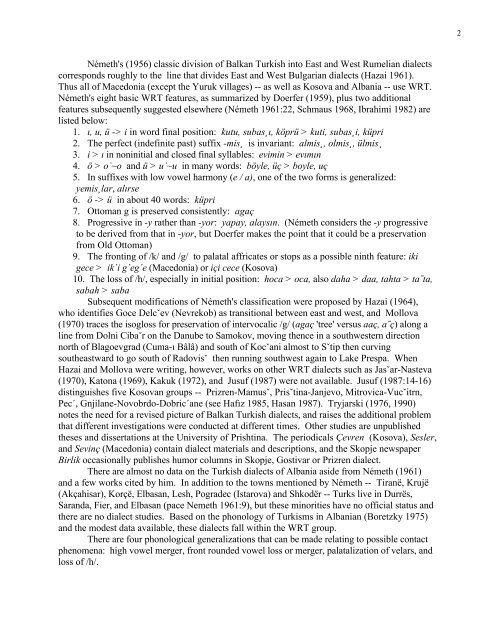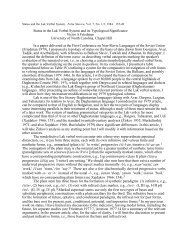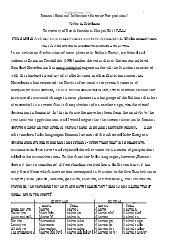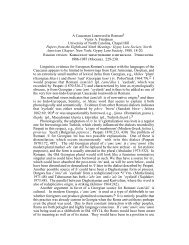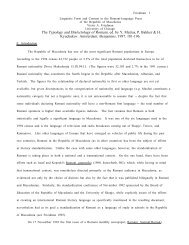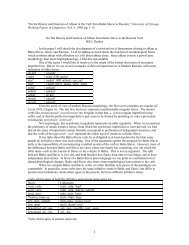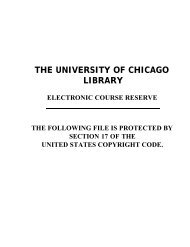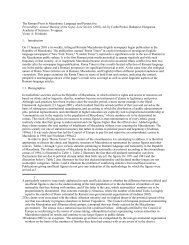Makedonia ve Civar Bölgelerde Balkan Türkçesi / Balkan Turkish in ...
Makedonia ve Civar Bölgelerde Balkan Türkçesi / Balkan Turkish in ...
Makedonia ve Civar Bölgelerde Balkan Türkçesi / Balkan Turkish in ...
You also want an ePaper? Increase the reach of your titles
YUMPU automatically turns print PDFs into web optimized ePapers that Google loves.
Németh's (1956) classic division of <strong>Balkan</strong> <strong>Turkish</strong> <strong>in</strong>to East and West Rumelian dialects<br />
corresponds roughly to the l<strong>in</strong>e that divides East and West Bulgarian dialects (Hazai 1961).<br />
Thus all of Macedonia (except the Yuruk villages) -- as well as Kosova and Albania -- use WRT.<br />
Németh's eight basic WRT features, as summarized by Doerfer (1959), plus two additional<br />
features subsequently suggested elsewhere (Németh 1961:22, Schmaus 1968, Ibrahimi 1982) are<br />
listed below:<br />
1. ı, u, ü -> i <strong>in</strong> word f<strong>in</strong>al position: kutu, subas¸ı, köprü > kuti, subas¸i, küpri<br />
2. The perfect (<strong>in</strong>def<strong>in</strong>ite past) suffix -mis¸ is <strong>in</strong>variant: almis¸, olmis¸, ülmis¸<br />
3. i > ı <strong>in</strong> non<strong>in</strong>itial and closed f<strong>in</strong>al syllables: evim<strong>in</strong> > evımın<br />
4. ö > o˙~o and ü > u˙~u <strong>in</strong> many words: böyle, üç > boyle, uç<br />
5. In suffixes with low vowel harmony (e / a), one of the two forms is generalized:<br />
yemis¸lar, alırse<br />
6. ö -> ü <strong>in</strong> about 40 words: küpri<br />
7. Ottoman g is preser<strong>ve</strong>d consistently: agaç<br />
8. Progressi<strong>ve</strong> <strong>in</strong> -y rather than -yor: yapay, alaysın. (Németh considers the -y progressi<strong>ve</strong><br />
to be deri<strong>ve</strong>d from that <strong>in</strong> -yor, but Doerfer makes the po<strong>in</strong>t that it could be a preservation<br />
from Old Ottoman)<br />
9. The front<strong>in</strong>g of /k/ and /g/ to palatal affricates or stops as a possible n<strong>in</strong>th feature: iki<br />
gece > ik´i g´eg´e (Macedonia) or içi cece (Kosova)<br />
10. The loss of /h/, especially <strong>in</strong> <strong>in</strong>itial position: hoca > oca, also daha > daa, tahta > ta¯ta,<br />
sabah > saba<br />
Subsequent modifications of Németh's classification were proposed by Hazai (1964),<br />
who identifies Goce Delcˇev (Nevrekob) as transitional between east and west, and Mollova<br />
(1970) traces the isogloss for preservation of <strong>in</strong>tervocalic /g/ (agaç 'tree' <strong>ve</strong>rsus aaç, a¯ç) along a<br />
l<strong>in</strong>e from Dolni Ciba˘r on the Danube to Samokov, mov<strong>in</strong>g thence <strong>in</strong> a southwestern direction<br />
north of Blagoevgrad (Cuma-ı Bâlâ) and south of Kocˇani almost to Sˇtip then curv<strong>in</strong>g<br />
southeastward to go south of Radovisˇ then runn<strong>in</strong>g southwest aga<strong>in</strong> to Lake Prespa. When<br />
Hazai and Mollova were writ<strong>in</strong>g, howe<strong>ve</strong>r, works on other WRT dialects such as Jasˇar-Nasteva<br />
(1970), Katona (1969), Kakuk (1972), and Jusuf (1987) were not available. Jusuf (1987:14-16)<br />
dist<strong>in</strong>guishes fi<strong>ve</strong> Kosovan groups -- Prizren-Mamusˇ, Prisˇt<strong>in</strong>a-Janjevo, Mitrovica-Vucˇitrn,<br />
Pec´, Gnjilane-Novobrdo-Dobric´ane (see Hafız 1985, Hasan 1987). Tryjarski (1976, 1990)<br />
notes the need for a revised picture of <strong>Balkan</strong> <strong>Turkish</strong> dialects, and raises the additional problem<br />
that different <strong>in</strong><strong>ve</strong>stigations were conducted at different times. Other studies are unpublished<br />
theses and dissertations at the Uni<strong>ve</strong>rsity of Prisht<strong>in</strong>a. The periodicals Çevren (Kosova), Sesler,<br />
and Sev<strong>in</strong>ç (Macedonia) conta<strong>in</strong> dialect materials and descriptions, and the Skopje newspaper<br />
Birlik occasionally publishes humor columns <strong>in</strong> Skopje, Gostivar or Prizren dialect.<br />
There are almost no data on the <strong>Turkish</strong> dialects of Albania aside from Németh (1961)<br />
and a few works cited by him. In addition to the towns mentioned by Németh -- Tiranë, Krujë<br />
(Akçahisar), Korçë, Elbasan, Lesh, Pogradec (Istarova) and Shkodër -- Turks li<strong>ve</strong> <strong>in</strong> Durrës,<br />
Saranda, Fier, and Elbasan (pace Nemeth 1961:9), but these m<strong>in</strong>orities ha<strong>ve</strong> no official status and<br />
there are no dialect studies. Based on the phonology of Turkisms <strong>in</strong> Albanian (Boretzky 1975)<br />
and the modest data available, these dialects fall with<strong>in</strong> the WRT group.<br />
There are four phonological generalizations that can be made relat<strong>in</strong>g to possible contact<br />
phenomena: high vowel merger, front rounded vowel loss or merger, palatalization of <strong>ve</strong>lars, and<br />
loss of /h/.<br />
2


